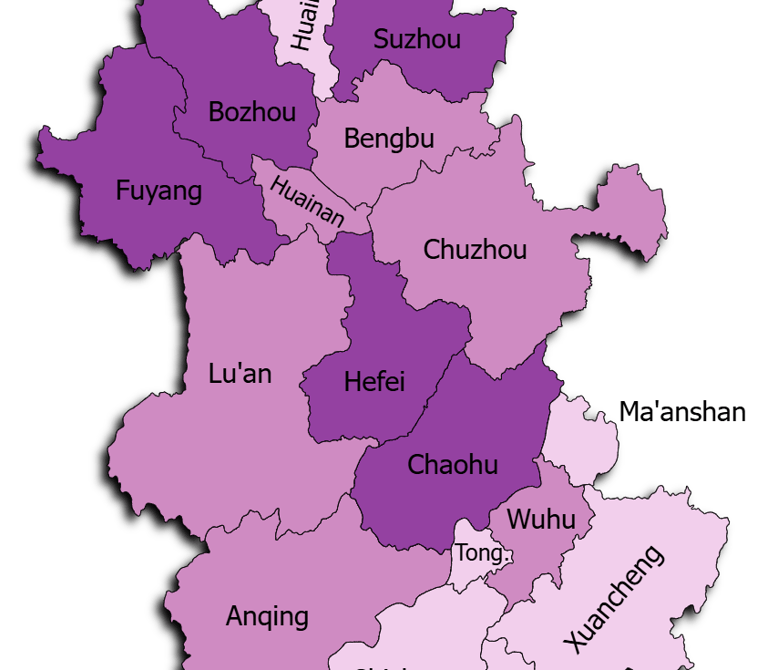Cities in Guizhou


Introduction
Hefei lies near the center of Anhui, between the Yangtze River and the Huai River. It has a population of about 9 million. The city is close to Chaohu Lake and the northeastern edge of the Dabie Mountains, combining flat plains with gentle hills. As the provincial capital, Hefei is the political, economic, and research hub of Anhui.


Guangzhou is located in central Guangdong Province along the Pearl River Delta, close to the South China Sea. The city has a population of about 19 million and sits approximately 140 km north of Hong Kong. Guangzhou is a large, international city known for its long history of trade and openness.
Historically, Guangzhou served as the starting point of the Maritime Silk Road, playing a central role in connecting China to Southeast Asia, the Middle East, and Europe. Today, it remains a major center for manufacturing, finance, technology, and international commerce, hosting large global trade exhibitions such as the Canton Fair.
The city is also an important academic center with leading universities including Sun Yat-sen University and South China University of Technology, contributing to research, innovation, and regional talent development.
📍 Main places to visit include Canton Tower, Chen Clan Ancestral Hall, Sun Yat-sen Memorial Hall, Shamian Island, Temple of the Six Banyan Trees, Huacheng Square.
Guangzhou (广州)
Shenzhen (深圳)
Shenzhen is located in southern Guangdong, bordering Hong Kong across the Shenzhen River. It has a population of roughly 18 million and is one of the most modern cities in China. Known for rapid development and innovation, it is often described as an experimental and forward-looking urban center.
Shenzhen transformed from a fishing town into a major technological and industrial hub after becoming China’s first Special Economic Zone (SEZ) in 1980. Today, it hosts the headquarters of major global technology companies including Huawei and Tencent.
The city also plays a key role in finance, international logistics, artificial intelligence, and advanced manufacturing. Shenzhen offers a strong education and research ecosystem, including Southern University of Science and Technology (SUSTech) and Shenzhen University.
📍 Main places to visit include Window of the World, Ping An Finance Center, Dafen Art Village, OCT Loft, Lianhuashan Park, Shenzhen Museum.




Foshan is located in the central Pearl River Delta, west of Guangzhou, with a population of around 9 million. The city is built on a flat river network with many waterways and is known for both its craft traditions and industrial development.
Foshan has a long heritage in ceramics, martial arts, and traditional crafts, and is recognized as the birthplace of Wing Chun. The city blends older historic districts with fast-growing manufacturing areas, especially in household appliances, construction materials, and robotics. Foshan has also developed strong education and research programs in applied industry and technology, supporting its regional role within the Greater Bay Area.
📍 Main places to visit include Foshan Ancestral Temple, Lingnan Tiandi, Nanfeng Ancient Kiln, Xiqiao Mountain, Zumiao Temple, Mt. Shunfengshan Park.
Foshan (佛山)
Dongguan (东莞)
Dongguan lies between Guangzhou and Shenzhen and has a population of around 10 million. It is often viewed as a manufacturing and supply-chain center within the region.
The city plays a key role in global production and is known for electronics, textiles, and industrial machinery. In recent years, it has shifted toward automation and high-technology development, supported by growing research centers and professional training institutions.
📍 Main places to visit include Opium War Museum, Humen Bridge, Yinxian Resort, Qifeng Park.
Zhuhai (珠海)
Zhuhai is located on the southern coast of Guangdong near the border with Macau and has a population of about 2 million. It is known for green spaces and coastal views.
The city is part of the Greater Bay Area and focuses on technology, tourism, and education. Zhuhai hosts several higher education institutions such as the University of Macau (new campus) and Beijing Normal University Zhuhai Campus, which support research and international exchange.
📍 Main places to visit include Lovers’ Road, Zhuhai Opera House, New Yuanming Palace, Chimelong Ocean Kingdom.




Huizhou (惠州)
Huizhou is located in southeastern Guangdong near the coast, with a population close to 6 million. It has lakes, hills, and coastal areas.
The city is recognized for its industries in electronics, petrochemicals, and renewable energy. It continues to grow as part of the Greater Bay Area development and has increasing research activities linked to nearby Shenzhen and Dongguan.
📍 Main places to visit include West Lake, Luofu Mountain, Honghua Lake, Pinghai Ancient City.
Zhongshan (中山)
Zhongshan is located in the southern Pearl River Delta, close to both Zhuhai and Guangzhou. It has a population of around 4 million. The city is named after Sun Yat-sen, who was born here.
Zhongshan is known for its role in electronics, lighting, and household manufacturing, as well as its historical connection to modern Chinese political history. The city combines modern industrial zones with preserved cultural sites and museums.
📍 Main places to visit include Sun Yat-sen Memorial Hall, Zhan Garden, Qijiang Park, Zimaling Park.




Navigation
Main Menu
nathan.china-sphere.com
© 2025. All rights reserved.